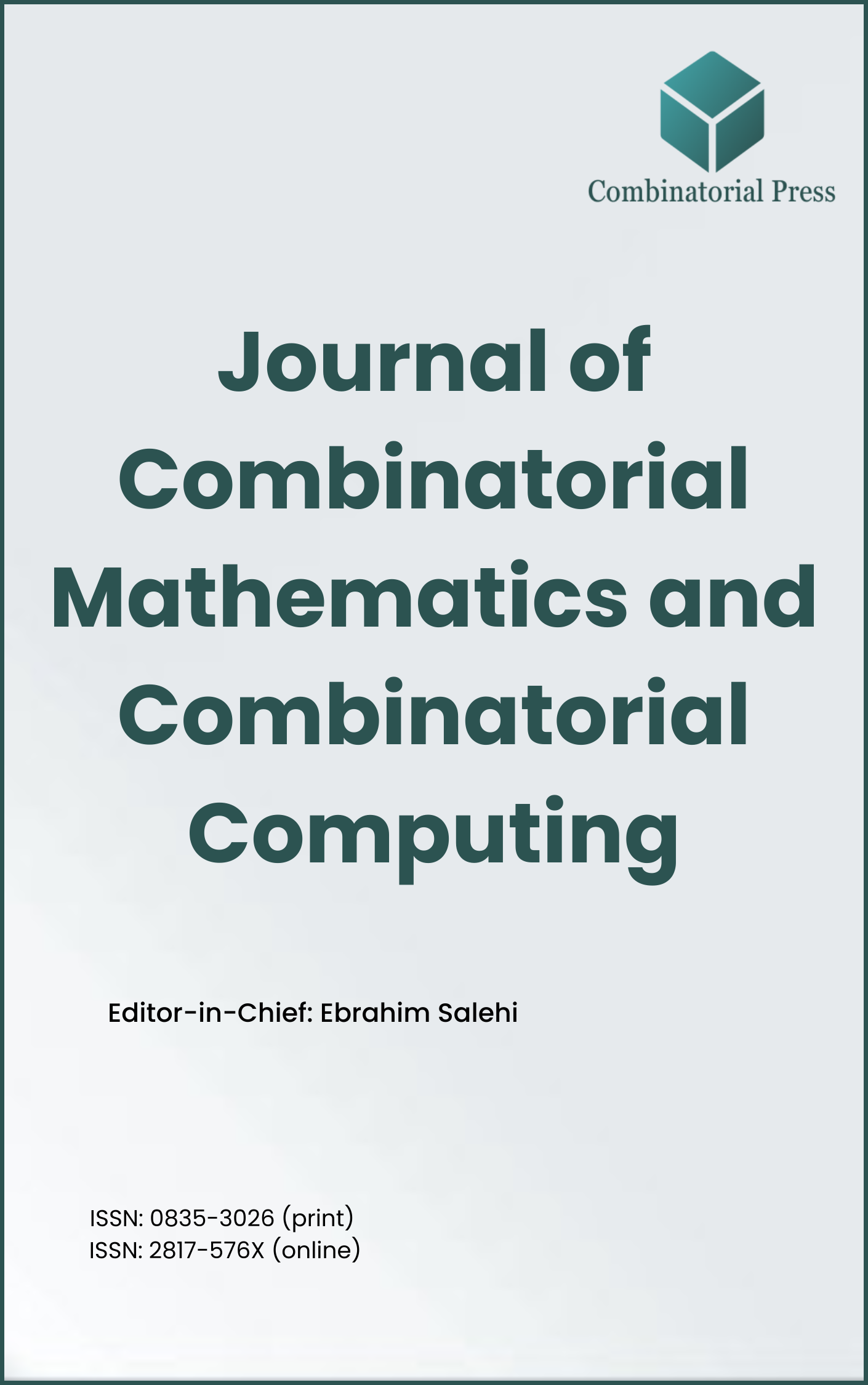
Journal of Combinatorial Mathematics and Combinatorial Computing
ISSN: 0835-3026 (print) 2817-576X (online)
The Journal of Combinatorial Mathematics and Combinatorial Computing (JCMCC) embarked on its publishing journey in April 1987. From 2024 onward, it publishes four volumes per year in March, June, September and December. JCMCC has gained recognition and visibility in the academic community and is indexed in renowned databases such as MathSciNet, Zentralblatt, Engineering Village and Scopus. The scope of the journal includes; Combinatorial Mathematics, Combinatorial Computing, Artificial Intelligence and applications of Artificial Intelligence in various files.
- Research article
- Full Text
- Journal of Combinatorial Mathematics and Combinatorial Computing
- Volume 004
- Pages: 87-96
- Published: 31/10/1988
In this paper, the algorithm developed in \([RK]\) for \(2\)-color Ramsey numbers is generalized to multi-colored Ramsey numbers. All the cyclic graphs yielding the lower bounds \(R(3,3,4) \geq 30\), \(R(3,3,5) \geq 45\), and \(R(3,4,4) \geq 55\) were obtained. The two last bounds are apparently new.
- Research article
- Full Text
- Journal of Combinatorial Mathematics and Combinatorial Computing
- Volume 004
- Pages: 79-86
- Published: 31/10/1988
Consider combinations of \(k\) out of \(n\) items as represented by bit-strings of length \(n\) with exactly \(k\) ones. An algorithm for generating all such combinations so that successive bit-strings differ by the interchange of a single \(01\) or \(10\) pair exists only if \(n\) is even and \(k\) is odd (except for the trivial cases where \(k = n, n-1, 0, 1\)). This was shown by Eades, Hickey, and Read \([4]\) (and others) but no explicit algorithm was given. Later, Carkeet and Eades \([3]\) gave an inefficient, exponential storage implementation. Here, we present an implementation of the algorithm of \([4]\) that is constant average time, and uses linear storage.
- Research article
- Full Text
- Journal of Combinatorial Mathematics and Combinatorial Computing
- Volume 004
- Pages: 69-78
- Published: 31/10/1988
The minimum cardinality of a pairwise balanced design on nineteen points is determined; a minimal design is exhibited containing \(13\) triples and \(22\) quadruples.
- Research article
- Full Text
- Journal of Combinatorial Mathematics and Combinatorial Computing
- Volume 004
- Pages: 53-68
- Published: 31/10/1988
It is shown that the collection of all the \(\dbinom{10}{3}\) triples chosen from a set of ten points can be partitioned into ten mutually disjoint \(2-(9,3,1)\) designs in precisely \(77\) non-isomorphic ways.
- Research article
- Full Text
- Journal of Combinatorial Mathematics and Combinatorial Computing
- Volume 004
- Pages: 37-52
- Published: 31/10/1988
A \((3,k,n,e)\) Ramsey graph is a triangle-free graph on \(n\) vertices with \(e\) edges and no independent set of size \(k\). Similarly, a \((3,k)\)-, \((3,k,n)\)-, or \((3,k,n,e)\)-graph is a \((3,k,n,e)\) Ramsey graph for some \(n\) and \(e\). In the first part of the paper, we derive an explicit formula for the minimum number of edges in any \((3,k,n)\)-graph for \(n\leq3(k-1)\), i.e., a partial formula for the function \(e(3,k,n)\) investigated in \([3,5,7]\). We prove some general properties of minimum \((3,k,n)\)-graphs with \(e(3,k,n)\) edges and present a construction of minimum \((3,k+1,3k-1,5k-5)\)-graphs for \(k\geq2\) and minimum \((3,k+1,3k,5k)\)-graphs for \(k\geq4\). In the second part of the paper, we describe a catalogue of small Ramsey graphs: all \((3,k)\)-graphs for \(k\leq6\) and some \((3,7)\)-graphs, including all \(191 (3,7,22)\)-graphs, produced by a computer. We present for \(k\leq7\) all minimum \((3,k,n)\)-graphs and all \(10\) maximum \((3,7,22)\)-graphs with \(66\) edges.
- Research article
- Full Text
- Journal of Combinatorial Mathematics and Combinatorial Computing
- Volume 004
- Pages: 29-36
- Published: 31/10/1988
The cost of a sorting algorithm is the number of primitive operations used in a worst-case execution of the algorithm. In the standard model, the primitive operation is a binary comparison, which sorts a pair of keys. Cost measures based on other primitive operations are considered. A general lower bound for the cost of a sorting algorithm is given, which is valid for a wide class of possible primitives. For several special primitive operations, sorting algorithms are given. The primitive operations studied are: sorting \(k\) keys, finding the largest among \(k\) keys, and merging lists of lengths \(i,j\).
- Research article
- Full Text
- Journal of Combinatorial Mathematics and Combinatorial Computing
- Volume 004
- Pages: 23-28
- Published: 31/10/1988
Hartman and Rosa have shown that the complete graph \(K_{2n}\) has an acyclic one-factorization if and only if \(n\) is not a power of \(2\) exceeding \(2\). Here, we consider the following problem: for which \(n > 0\) and \(0 < k < \frac{n}{2}\) does the complete graph \(K_n\) admit a cyclic decomposition into matchings of size \(k\)? We give a complete solution to this problem and apply it to obtain a new class of perfect coverings.
- Research article
- Full Text
- Journal of Combinatorial Mathematics and Combinatorial Computing
- Volume 004
- Pages: 19-22
- Published: 31/10/1988
- Research article
- Full Text
- Journal of Combinatorial Mathematics and Combinatorial Computing
- Volume 004
- Pages: 3-18
- Published: 31/10/1988
The integrity of a graph \(G\), denoted \(I(G)\), is defined by \(I(G) := \min_{S \subset V(G)} \{|S| + m(G – S)\}\), where \(m(G – S)\) denotes the maximum order of a component of \(G – S\). In this paper, we explore the integrity of various combinations of graphs in terms of the integrity and other graphical parameters of the constituent graphs. Specifically, explicit formulae and/or bounds are derived for the integrity of the join, union, cartesian and lexicographic products of two graphs. Also, some results on the integrity of powers of graphs are given.
- Research article
- Full Text
- Journal of Combinatorial Mathematics and Combinatorial Computing
- Volume 003
- Pages: 213-222
- Published: 30/04/1988
A basis is exhibited for the first homology space of a surface over a field. This basis is found by extending a basis of the boundary cycle space of an embedded graph to the cycle space of the graph.





